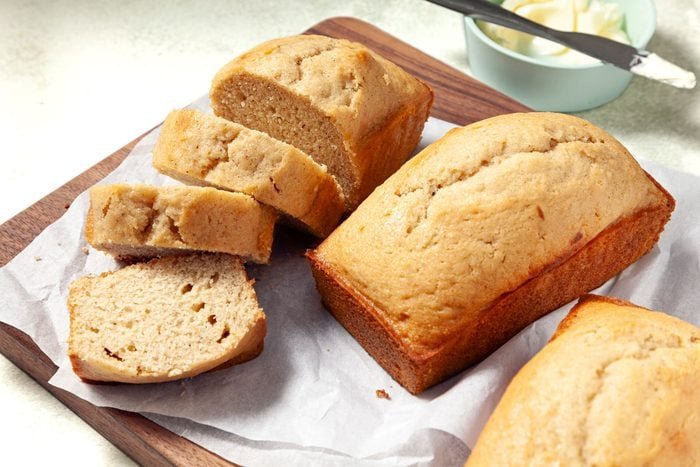May 15, 2025
Eggnog Sourdough Bread: A Festive Holiday Loaf for 2025
The Heritage of Eggnog and Sourdough
Eggnog, a creamy concoction of milk, eggs, sugar, and spices, traces its roots to medieval England, where it evolved from “posset,” a hot drink of milk curdled with wine or ale. By the 17th century, colonists in America adapted the recipe, using rum or bourbon and adding nutmeg, creating the eggnog we know today. Its association with Christmas grew in the 19th century, as families shared it during holiday gatherings, a tradition reflected in modern recipes from The Kitchn and Serious Eats.
Sourdough, one of humanity’s oldest breads, dates back to ancient Egypt around 3000 BCE. Its natural fermentation, driven by wild yeast and lactobacilli, creates a tangy flavor and chewy texture, celebrated in modern baking communities like those on Reddit’s r/Breadit and X. The 2020s sourdough boom, fueled by home baking during lockdowns, continues in 2025, with bakers experimenting with creative enrichments like eggnog.
Eggnog Sourdough Bread marries these traditions, blending the festive warmth of eggnog with the artisanal depth of sourdough. Inspired by recipes from Breadtopia and King Arthur Baking, it’s a nod to holiday nostalgia and modern craftsmanship, perfect for a season of sharing and indulgence.
The Eggnog Sourdough Bread Recipe
This recipe yields one 9×5-inch loaf, serving 10–12, and takes about 18–24 hours, including overnight fermentation, with active prep time of 1.5 hours. It’s vegetarian, enriched with eggnog and butter for a tender crumb, and uses a mature sourdough starter for flavor. Below are detailed steps, ingredient notes, and pro tips for success.
Ingredients
For the Dough:
- Active Sourdough Starter: 100g (100% hydration, fed 8–12 hours prior)
- Bread Flour: 350g (about 2¾ cups)
- All-Purpose Flour: 50g (about ⅓ cup)
- Eggnog: 200g (¾ cup + 2 tbsp, store-bought or homemade, at room temperature)
- Water: 50g (¼ cup, lukewarm)
- Sugar: 50g (¼ cup, granulated)
- Butter: 50g (3½ tbsp, softened)
- Egg: 1 large (about 50g)
- Salt: 8g (1½ tsp)
- Nutmeg: ½ tsp, freshly grated
- Vanilla Extract: 1 tsp, pure
For Optional Glaze (Sweet Finish):
- Powdered Sugar: ½ cup
- Eggnog: 1–2 tbsp
- Nutmeg: Pinch, for dusting
Equipment
- Large mixing bowl or stand mixer with dough hook
- Kitchen scale (for precision)
- Measuring cups and spoons
- 9×5-inch loaf pan, greased or parchment-lined
- Bench scraper
- Proofing basket or bowl (optional)
- Lame or sharp knife (for scoring)
- Cooling rack
Instructions
- Feed the Starter: 8–12 hours before mixing, feed your sourdough starter (1:2:2 ratio of starter:flour:water) and let it peak at room temperature (76°F). It should be bubbly and double in size.
- Mix the Dough: In a large bowl or stand mixer, combine active starter, eggnog, water, sugar, egg, and vanilla extract. Mix until smooth. Add bread flour, all-purpose flour, salt, and nutmeg, stirring until a shaggy dough forms. Let rest (autolyse) for 30 minutes to hydrate the flour.
- Incorporate Butter: Add softened butter in small pieces, kneading by hand or mixing on low speed for 7–10 minutes until fully incorporated and the dough is smooth and slightly tacky. It should pass the windowpane test (stretch a small piece until light passes through without tearing).
- Bulk Fermentation: Place the dough in a lightly oiled bowl, cover, and ferment at room temperature (76°F) for 8–12 hours or overnight, until doubled in size. Perform 3–4 stretch-and-folds (every 30 minutes for the first 2 hours) to build structure. For a warmer or cooler kitchen, adjust timing (6–8 hours at 80°F, 12–14 hours at 70°F).
- Shape the Dough: Turn the dough onto a lightly floured surface. Gently deflate and shape into a tight rectangle to fit a 9×5-inch loaf pan. Place seam-side down in the greased or parchment-lined pan. Alternatively, shape into a boule and proof in a basket for a rustic loaf.
- Final Proof: Cover and proof at room temperature for 2–4 hours, until the dough rises about 1 inch above the pan’s rim or passes the poke test (a gentle poke leaves a slow-recovering indent). Preheat the oven to 375°F during the final 30 minutes.
- Bake: Score the dough with a shallow slash to control expansion. Bake for 35–40 minutes, until golden brown and the internal temperature reaches 190–200°F. If the top browns too quickly, tent with foil after 25 minutes. Remove from the pan and cool on a rack for at least 2 hours before slicing.
- Optional Glaze: Whisk powdered sugar with eggnog until smooth. Drizzle over the cooled loaf and dust with nutmeg for a festive touch.
- Serve: Slice and serve fresh, toasted, or as part of a holiday spread. Store wrapped at room temperature for 2–3 days or freeze for up to 1 month.
Yield and Timing
- Servings: 10–12 slices
- Prep Time: 1.5 hours (active)
- Fermentation and Proofing: 10–16 hours
- Cook Time: 35–40 minutes
- Total Time: ~18–24 hours

Nutritional Information (Per Slice, Approximate, for 12 slices, Without Glaze)
- Calories: 200 kcal
- Protein: 6g
- Fat: 5g
- Carbohydrates: 32g
- Sodium: 220mg
Note: Values vary based on eggnog brand and glaze.
Tips for Success
- Use an Active Starter: Ensure your starter is at peak activity (bubbly and doubled) for optimal rise and flavor. A sluggish starter may lead to dense bread.
- Choose Quality Eggnog: Store-bought eggnog (e.g., Organic Valley) or homemade versions with real eggs and cream yield the richest flavor. Avoid low-fat or overly sweet varieties.
- Monitor Dough Hydration: Eggnog’s thickness varies; adjust water (1 tbsp at a time) if the dough feels too dry or sticky during mixing.
- Control Fermentation: In a cold kitchen, place the dough in a turned-off oven with a bowl of warm water to maintain 76–80°F. Check progress every few hours.
- Score Carefully: A shallow slash prevents the loaf from bursting unevenly. For a rustic look, dust with flour before scoring.
Variations and Serving Ideas
Eggnog Sourdough Bread is a versatile canvas for holiday creativity. Here are popular variations and serving suggestions to elevate your loaf.
Variations
- Vegan: Replace eggnog with a plant-based version (e.g., almond or oat eggnog), use vegan butter, and swap the egg for 3 tbsp aquafaba or a flax egg (1 tbsp ground flaxseed + 3 tbsp water).
- Spiced Up: Add ½ tsp cinnamon or ¼ tsp ground cloves to the dough for extra warmth. Fold in ½ cup dried cranberries or raisins for texture.
- Nutty Crunch: Incorporate ⅓ cup chopped pecans or walnuts during shaping for a festive crunch.
- Gluten-Free: Use a gluten-free sourdough starter and a 1:1 gluten-free bread flour blend, adjusting hydration and proofing times as needed.
- Sweet Swirl: Roll the dough into a rectangle, spread with a cinnamon-sugar-butter mix, and roll up for a swirled loaf, baking in a loaf pan.
- Savory Twist: Omit sugar and nutmeg, adding ½ cup grated cheddar and 1 tsp dried thyme for a savory loaf that pairs with soups.
Serving Suggestions
- Holiday Breakfast: Toast slices and spread with butter or cream cheese, serving with coffee or mulled cider for a festive start.
- Brunch Star: Use for French toast, soaking slices in an eggnog-based custard and topping with maple syrup and whipped cream.
- Gifting: Wrap the cooled loaf in parchment and twine, attaching a recipe card, for a heartfelt holiday gift.
- Cheese Board: Serve thin slices with brie, fig jam, and walnuts for an elegant appetizer.
- Dessert: Cube leftover bread for bread pudding, baking with an eggnog custard and a bourbon glaze for decadence.
Cultural Significance and Modern Appeal
Eggnog Sourdough Bread bridges two cherished traditions: the festive indulgence of eggnog and the time-honored craft of sourdough. Eggnog’s role in Christmas celebrations, from caroling parties to family toasts, imbues the bread with holiday spirit, while sourdough’s slow fermentation reflects a return to mindful, hands-on cooking. In 2025, as seen in posts on X and baking blogs like The Perfect Loaf, bakers are embracing enriched sourdoughs, incorporating seasonal ingredients like pumpkin or chocolate for unique loaves.
This bread’s appeal lies in its balance of nostalgia and innovation. Its golden crust and spiced aroma evoke winter gatherings, while its sourdough base aligns with wellness trends, offering better digestibility and complex flavor. Affordable at about $0.75 per slice, it’s a budget-friendly showstopper for holiday tables, and its rustic look—especially with a powdered sugar glaze—makes it a social media favorite for #HolidayBaking posts.
Health Benefits and Dietary Considerations
Eggnog Sourdough Bread offers nutritional benefits:
- Digestibility: Sourdough’s fermentation reduces gluten and phytic acid, improving nutrient absorption and gut health.
- Protein and Calcium: Eggnog and eggs provide protein (6g per slice) and calcium for muscle and bone health.
- Moderate Fat: Butter and eggnog add richness but keep fat content reasonable at 5g per slice.
- Energy: Carbohydrates from flour and sugar fuel holiday activities.
To tailor to specific diets:
- Vegan: Use plant-based eggnog, vegan butter, and a flax egg, as noted in variations.
- Low-Sugar: Reduce sugar to 2 tbsp and use a low-sugar eggnog; skip the glaze.
- Gluten-Free: Experiment with gluten-free sourdough blends, though texture may differ.
- Low-Fat: Replace butter with applesauce and use low-fat eggnog, adjusting water for hydration.
Pair this bread with a post-brunch walk, as promoted by National Walking Day (April 2, 2025). A 30-minute stroll burns 150–200 calories, balancing the loaf’s indulgent richness.
Storage and Make-Ahead Tips
Eggnog Sourdough Bread is ideal for holiday planning:
- Make Ahead: Prepare the dough and complete bulk fermentation up to 12 hours in advance, refrigerating after shaping for a final proof of 8–12 hours.
- Storage: Store wrapped in a clean cloth or plastic at room temperature for 2–3 days. Refrigerate for up to 5 days to maintain freshness, though the crust may soften.
- Freezing: Freeze the whole loaf or slices, wrapped tightly in plastic and foil, for up to 1 month. Thaw at room temperature and reheat at 300°F for 10 minutes.
- Repurposing: Use stale bread for croutons, stuffing, or a holiday strata with eggs and cheese.
Community and Social Engagement
Eggnog Sourdough Bread is perfect for holiday gatherings, gifting, or virtual baking challenges. Share your loaf on social media with hashtags like #EggnogSourdough or #HolidayBaking2025 to connect with bakers worldwide. Engage on platforms like Reddit’s r/Sourdough or X, swapping tips like adding rum extract for extra eggnog flavor or using a Dutch oven for a crustier loaf. Host a “Holiday Bread Swap,” where guests bring their favorite loaves, pairing this bread with mulled wine or hot cocoa for a festive tasting.

Conclusion
Eggnog Sourdough Bread is a celebration of holiday warmth, artisanal craft, and seasonal indulgence. Its tender, spiced crumb and golden crust bring the flavors of Christmas to life, blending the creamy richness of eggnog with the tangy depth of sourdough. Rooted in centuries-old traditions and tailored for 2025’s baking renaissance, this loaf is a standout for festive gatherings and quiet mornings alike. Whether you’re slicing it for brunch or gifting it to a neighbor, it’s a heartfelt expression of the season’s joy.
More Details